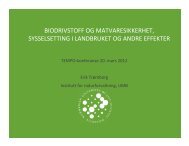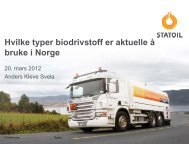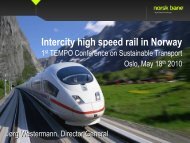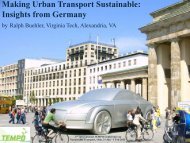Carbon Neutral
Carbon Neutral
Carbon Neutral
Create successful ePaper yourself
Turn your PDF publications into a flip-book with our unique Google optimized e-Paper software.
Climate Impact of Biofuels<br />
Glen Peters<br />
Center for International Climate and<br />
Environmental Research – Oslo<br />
(CICERO)
Key Questions<br />
• Does biofuel X have a climate benefit?<br />
• Is there sufficient resource of biofuel X?<br />
• (at a reasonable cost)<br />
• Does biofuel X have unintended<br />
consequences<br />
• Next presentations…
Conclusion<br />
• Biofuels can help meet climate objectives, but<br />
• Some biofuels are good<br />
• Some biofuels are bad (even ugly)<br />
• There are no silver-bullets<br />
• Case specific<br />
• Constraint issues<br />
• Research and Policy Question<br />
“What is the best utilisation of biomass resources?”
This presentation focuses on principles<br />
and not on specifics<br />
The principles to assess biofuels are static<br />
The specifics will change (biofuel X may go from bad to good)
CO 2 is CO 2<br />
Treat a molecule of CO 2 the same if is from<br />
fossil fuels, biomass, or wherever<br />
Fossil fuel<br />
Biomass
“<strong>Carbon</strong> <strong>Neutral</strong>”<br />
Used, Abused and Confused<br />
• “Biofuels are good because the carbon<br />
emitted equals the carbon absorbed”<br />
• Depends on the system boundary (area)<br />
• Depends on the time (how long)<br />
• Depends on management (e.g., early<br />
harvest, fertilizers, …)<br />
• Depends on biophysical factors (albedo)<br />
• Depends on use (replacing gasoline,<br />
construction timber, …)<br />
• Depends on indirect effects<br />
• …
“<strong>Carbon</strong> <strong>Neutral</strong>”<br />
Used, Abused and Confused<br />
• “Biofuels are good because the carbon<br />
emitted equals the carbon absorbed”<br />
• Depends on the system boundary (area)<br />
• Depends<br />
We can’t<br />
on<br />
just<br />
the time<br />
assume<br />
(how<br />
that<br />
long)<br />
all<br />
• Depends<br />
biomass<br />
on<br />
is<br />
management<br />
“carbon neutral”<br />
(e.g., early<br />
harvest, fertilizers, …)<br />
• Depends on<br />
…it<br />
biophysical<br />
depends<br />
factors (albedo)<br />
• Depends on use (replacing gasoline,<br />
construction timber, …)<br />
• Depends on indirect effects<br />
• …
SPATIAL BOUNDARIES
“<strong>Carbon</strong> <strong>Neutral</strong>”<br />
Where does the term come from?<br />
• Energy and land-use change reported in<br />
different categories<br />
• Bio-energy is both energy and LUC!<br />
• Energy: “CO 2 emissions resulting from<br />
bioenergy consumption should not be<br />
included in [the official inventory]”<br />
• LUC based on “stock-change”: If there is a<br />
change in stock, there is a source or a sink<br />
of carbon
“<strong>Carbon</strong> <strong>Neutral</strong>”<br />
Where does the term come from?<br />
• Energy and land-use change reported in<br />
different categories<br />
• Bio-energy is both energy and LUC!<br />
• Energy: Problem “COis 2 emissions linking bio-energy resulting from<br />
bioenergy from energy consumption and land-use should not be<br />
included in [the reporting official inventory]”<br />
• LUC based on “stock-change”: If there is a<br />
change in stock, there is a source or a sink<br />
of carbon
“<strong>Carbon</strong> <strong>Neutral</strong>”<br />
Where does the term come from?<br />
• National Emissions Accounting<br />
• Stock-change (this is used in policy)<br />
• If no change in carbon stock, then somewhere<br />
in the country biomass grew to replace the<br />
biomass used<br />
• Atmospheric-flow (alternative, not used)<br />
• Follows the fluxes of carbon in and out of the<br />
atmosphere<br />
• Both systems have (dis)advantages
“<strong>Carbon</strong> <strong>Neutral</strong>”
“<strong>Carbon</strong> <strong>Neutral</strong>”<br />
Key issues:<br />
• Ease of accounting<br />
• Linking sources and sinks of carbon<br />
• Inconsistent system boundaries (not all countries included)<br />
• International trade (transfer of carbon)<br />
• Harvested Wood Products (HWP) (storage of carbon)<br />
Glen’s view on spatial boundaries<br />
* National reporting: Stock-change approach<br />
* LCA, biofuels: Atmospheric-flow approach
TIME SCALES
“<strong>Carbon</strong> <strong>Neutral</strong>”<br />
CO 2 flux<br />
Time<br />
Assume no time dimension<br />
(or less than a year)
Sugar Cane<br />
“<strong>Carbon</strong> <strong>Neutral</strong>”<br />
CO 2 flux<br />
Time<br />
1 year – Sugar cane
Boreal Forests<br />
“<strong>Carbon</strong> <strong>Neutral</strong>”<br />
CO 2 flux<br />
Time<br />
100 years – Boreal forests
Fossil Fuels<br />
Not carbon neutral?<br />
CO 2 flux<br />
Time<br />
Millions of years - Fossil-fuels
Considering Time<br />
• There is a time lag between the sources<br />
(biofuel use) and sinks (biomass growth)<br />
• Is “carbon neutral” over 100 years the<br />
same as “carbon neutral” over 1 year?<br />
• Even if “carbon neutral” (flux concept)<br />
may not be “climate neutral” due to the<br />
time lag
FROM “CARBON NEUTRAL”<br />
TO “CLIMATE NEUTRAL”
“CARBON NEUTRAL”<br />
ZERO STOCK CHANGE
<strong>Carbon</strong> in the atmosphere<br />
Treating carbon dynamics<br />
explicitly…<br />
– Changes in carbon pools<br />
• E.g., biomass to<br />
atmosphere<br />
– <strong>Carbon</strong> in the<br />
atmosphere causes a<br />
forcing<br />
Above ground<br />
carbon stock<br />
Atmosphere<br />
22<br />
Y CO2<br />
in
“Fossil Fuel”, GWP=1<br />
“<strong>Carbon</strong> <strong>Neutral</strong>”, GWP=0<br />
23
“Fossil Fuel”, GWP=1<br />
All else equal, time makes bio-energy better<br />
than fossil fuels, but not “climate neutral”<br />
“<strong>Carbon</strong> <strong>Neutral</strong>”, GWP=0<br />
24
Open questions…<br />
• <strong>Carbon</strong> dynamics not thoroughly studied:<br />
– What initial conditions?<br />
– Single or multiple plots?<br />
– Different metric?<br />
• Radiative Forcing<br />
• Temperature<br />
Atmosphere<br />
Y CO2<br />
in<br />
Above ground<br />
carbon stock
Metric comparison<br />
Different metrics for a harvest<br />
cycle of around 40 years<br />
26
Experimental Set Up<br />
Set up<br />
Instantaneous<br />
Forcing and<br />
Temperature<br />
Integrated<br />
Forcing and<br />
Temperature<br />
Single plot, harvest first Warming TT 1<br />
Single plot, harvest second Cooling TT 2<br />
Infinite plots, harvest first Warming Warming<br />
Infinite plots, harvest second Cooling Cooling<br />
All else equal, all options better than fossil fuels…
Experimental Set Up<br />
Set up<br />
Instantaneous<br />
Forcing and<br />
Temperature<br />
Integrated<br />
Forcing and<br />
Temperature<br />
Landscape view perspective, if zero stockchange<br />
over time:<br />
• Moving from forest to forestry warms, but<br />
Single plot, harvest first Warming TT 1<br />
Single plot, better harvest than second fossil Cooling fuels TT forestry 2 cools<br />
Infinite plots, harvest first Warming Warming<br />
Infinite plots, harvest second Cooling Cooling<br />
All else equal, all options better than fossil fuels…
LANDSCAPE VIEW<br />
CHANGE IN STOCK
Norwegian examples<br />
• Transition to a situation of INCREASED<br />
harvest<br />
• Non-zero stock-change<br />
• A particular dynamic (ie, case study)<br />
– Results do not apply to all biomass, in all<br />
countries, in all situations…<br />
• NTNU, Holtsmark, Randers, outside of<br />
Norway, … studies show a period of “pay<br />
back”
Payback Norway<br />
Study Scenario for increased harvest Payback (years)<br />
Pellets replace coal 200<br />
Holtsmark<br />
Biofuels replace petrol 350<br />
Randers Biomass replaces oil heating >100<br />
Biofuel (FTD) replaces diesel<br />
RF no albedo >100<br />
integrated RF no albedo >100<br />
Bright et al<br />
Biofuel (FTD) replaces diesel<br />
RF with albedo ‐45 (30‐70)<br />
integrated RF with albedo ‐80 (45‐>100)<br />
Mix of assumptions on<br />
efficiency, forest growth,<br />
etc
Payback Norway<br />
Study Scenario for increased harvest Payback (years)<br />
Pellets replace coal 200<br />
HoltsmarkImproving<br />
• Biofuels Optimized replace usepetrol 350<br />
Randers • Biomass Technology replaces of conversion oil heating (efficiency) >100<br />
• Biofuel Forest (FTD) management replaces diesel<br />
• … RF no albedo >100<br />
integrated RF no albedo >100<br />
Bright et al<br />
Reduces these numbers and makes<br />
biofuels Biofuel (FTD) better replaces diesel<br />
RF with albedo ‐45 (30‐70)<br />
integrated RF with albedo ‐80 (45‐>100)<br />
Mix of assumptions on<br />
efficiency, forest growth,<br />
etc
Payback Norway<br />
Study Scenario for increased harvest Payback (years)<br />
Pellets replace coal 200<br />
Holtsmark<br />
Biofuels replace petrol 350<br />
Randers Biomass replaces oil heating >100<br />
Biofuel (FTD) replaces diesel<br />
RF no albedo >100<br />
integrated RF no albedo >100<br />
Bright et al<br />
Biofuel (FTD) replaces diesel<br />
RF with albedo ‐45 (30‐70)<br />
integrated RF with albedo ‐80 (45‐>100)<br />
Albedo changes everything<br />
Mix of assumptions on<br />
efficiency, forest growth,<br />
etc
ALBEDO
Albedo<br />
• Some incoming solar radiation is reflected<br />
back to space<br />
• Albedo gives the share reflected back<br />
• Albedo = 0, black, absorbs energy<br />
• Albedo = 1, white, reflects energy<br />
• Boreal areas have snow!
Bad<br />
Good<br />
In boreal areas, albedo<br />
gives biofuels a “kick start”<br />
Bad<br />
Good
INDIRECT LAND USE CHANGE
Payback global<br />
Concept of “carbon payback” or<br />
“carbon debt”<br />
• Just like most investments, it<br />
takes time to payback the<br />
initial investment<br />
• Cropland converted to<br />
biomass<br />
• Nearly always good<br />
• Forest converted to biomass<br />
• Takes time…
Good: Converting degraded land to biofuels<br />
Bad: Converting primary forests to biofuels<br />
Bad<br />
Good
WHICH BIOFUEL TO USE?
Gasoline<br />
Diesel<br />
Heat<br />
Biomass is “better”<br />
for electricity…
RESOURCES
Potential<br />
Resource<br />
Expert<br />
Opinion<br />
Technical<br />
Potential<br />
Model<br />
range
CONCLUSION
Conclusion<br />
• Biofuels can help meet climate objectives, but<br />
• Some biofuels are good<br />
• Some biofuels are bad (even ugly)<br />
• There are no silver-bullets<br />
• Case specific<br />
• Constraint issues<br />
• Research and Policy Question<br />
“What is the best utilisation of biomass resources?”








![[Wider Economic Benefits of transport]](https://img.yumpu.com/37676456/1/190x143/wider-economic-benefits-of-transport.jpg?quality=85)
